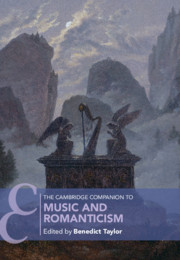Book contents
- The Cambridge Companion to Music and Romanticism
- Cambridge Companions to Music
- The Cambridge Companion to Music and Romanticism
- Copyright page
- Contents
- Figures
- Tables
- Musical Examples
- Contributors
- Preface
- Chronology
- Part I Horizons
- Part II Worlds
- Part III Aesthetics
- 10 Music in Early German Romantic Philosophy
- 11 Meaning and Value in Romantic Musical Aesthetics
- 12 Music and Romantic Interiority
- 13 Music, Expression, and the Aesthetics of Authenticity
- Part IV Practices
- Part V Histories
- Select Bibliography
- Index
- References
12 - Music and Romantic Interiority
from Part III - Aesthetics
Published online by Cambridge University Press: 06 August 2021
- The Cambridge Companion to Music and Romanticism
- Cambridge Companions to Music
- The Cambridge Companion to Music and Romanticism
- Copyright page
- Contents
- Figures
- Tables
- Musical Examples
- Contributors
- Preface
- Chronology
- Part I Horizons
- Part II Worlds
- Part III Aesthetics
- 10 Music in Early German Romantic Philosophy
- 11 Meaning and Value in Romantic Musical Aesthetics
- 12 Music and Romantic Interiority
- 13 Music, Expression, and the Aesthetics of Authenticity
- Part IV Practices
- Part V Histories
- Select Bibliography
- Index
- References
Summary
The listening posture that accompanied the rise of Romantic musical aesthetics in the late 1790s was decidedly inward-facing. Valorising interior response over external circumstance, Romantic listeners sought to be catapulted into a world of feeling and imagination, a world that stretched inward to the affects and outward to the realm of nature. Taking E. T. A. Hoffmann’s Kreisleriana as a point of departure, this essay identifies three guiding principles of musical Romanticism: that music is inscrutably deep or profound, that musical sounds penetrate into and change the listener’s inner world, and that music is capable of transporting listeners to a more ideal, and markedly spiritual, state of being. The essay shows how these principles undergird broader Romantic convictions about the relationship between music and interiority, as evidenced by authors ranging from Hoffmann, W. H. Wackenroder, and Bettina von Arnim to G. W. F. Hegel, Arthur Schopenhauer, and Malwida von Meysenbug.
Keywords
- Type
- Chapter
- Information
- The Cambridge Companion to Music and Romanticism , pp. 199 - 213Publisher: Cambridge University PressPrint publication year: 2021



